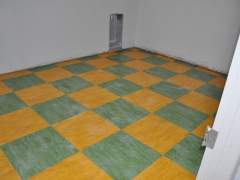The popularity of marmoleum among the homeowners increases every month – let’s talk on the main advantages and disadvantages of this relativity young type of flooring.
 Marmoleum production is growing rapidly nowadays. Marmoleum is likely to replace all types of floor coverings in the nearest future. It has overrun all types of wood flooring made of precious timber (which will remain as a luxury item, nevertheless). Below we will talk about the marmoleum flooring pros and cons.
Marmoleum production is growing rapidly nowadays. Marmoleum is likely to replace all types of floor coverings in the nearest future. It has overrun all types of wood flooring made of precious timber (which will remain as a luxury item, nevertheless). Below we will talk about the marmoleum flooring pros and cons.
What is marmoleum?
By the early ’90s cheaper and more quality substitutes of linseed oil (which is part of the linoleum) were discovered. Simultaneously, the third intermediate layer of agglomerated cork was added to linoleum structure. The finishing touch was the use of technology of hot dry pressing. In fact, marmoleum is linoleum made up to the limit of perfection (Read more).
Marmoleum pros and cons
Marmoleum has truly outstanding advantages:
- It’s absolutely eco-friendly – it’s made od natural ingredients ONLY.
- It’s non-toxic, non-allergenic and it has antibacterial properties.
- It’s cheaper than the cheapest of the present-day materials – laminate.
- Marmoleum floor does not require additional insulation and thermal insulation – the material itself possesses insulating properties.
- It’s hygienic and very resistant: it does not fade, does not swell, it can withstand great loads.
- Warranty lifetime of marmoleum is 20 years, but, judging by the structure and manufacturing technology, in the future it will be increased up to 100 years.
- Marmoleum does not accumulate static electricity, it’s non-flammable: if you
 throw a match that was burning a moment ago on it, it will leave no trace on the flooring.
throw a match that was burning a moment ago on it, it will leave no trace on the flooring. - This material is absolutely decorative: it can be painted in various colors, it may be textured as wood, stone, etc. Currently they produce marmoleum of 100 primary colors and 2000 shades.
- Finally, marmoleum is extremely easy in use: even a preschooler can install it, literally.
- It’s super easy to clean marmoleum – just use a mop and water; moreover it’s not so afraid of water as laminate and linoleum are.
The most common disadvantages of marmoleum:
- Marmoleum is very fragile, especially at the edges of the sheet, so, working with it, you should previously learn certain rules.
 Over the time, marmoleum spreads and hardens. Of course, it sounds like a rather good thing for flooring: it is not necessary to seal the seams carefully, to do converge. But when you buy marmoleum, you need to study it very carefully. If the boxes with rolls were neglected during transporting, parts of the material may be cracked, so the seller must always look for a guarantee.
Over the time, marmoleum spreads and hardens. Of course, it sounds like a rather good thing for flooring: it is not necessary to seal the seams carefully, to do converge. But when you buy marmoleum, you need to study it very carefully. If the boxes with rolls were neglected during transporting, parts of the material may be cracked, so the seller must always look for a guarantee.- Being quite heavy, marmoleum retains residual plasticity along the layers for a very long time. Once again, it sounds good for flooring: there is no need for careful alignment of framework – the irregularities in a quarter or even a third of its thickness is not a problem for you anymore. But marmoleum used for the walls, for example, should not be so: it will soon begin to “float” under its own weight. But if we talk about marmoleum flooring, we don’t deal with this aspect.
- Marmoleum is very hard to be cut (unlike laminate or MDF), it is impossible to achieve super straight cutting. Therefore, marmoleum is cut only along the walls. But the decorative possibilities of marmoleum help a lot: standard patterns will hide the lack of straightness.



